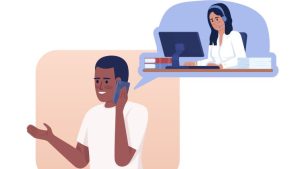Why Nonverbal Communication is Important in Virtual Job Interviews
 Publié le 24 July 2023
Publié le 24 July 2023
Improve your chances of making a strong impression on recruiters and hiring managers by learning why nonverbal communication is important in virtual job interviews.
Virtual job interviews have become increasingly common in recent years. Along with meetings and even staff social gatherings, interviews have taken their place in the remote sphere and a great many of us have had to get used to them.
What are the primary factors to think about when preparing for a virtual job interview? Certain elements have to be in place. A decent internet connection. An adequate laptop with working microphone and camera. A background that won’t rule you out of contention straight away (or endanger your security and privacy). A plan to promote your skills and experiences.
Beyond these, there are still additional factors that can impact your chances with a hiring manager, especially body language and other related elements. Let’s take a closer look at why nonverbal communication is important in virtual job interviews.
What is Nonverbal Communication?
There have been a lot of great communicators in history, who have shaped the hearts and minds of the crowds they were addressing.
What great communicators understand that it is not only just about what they say but how they say it. And by this doesn’t only mean voice tone, pitch or volume.
It might be stance. It might be gesticulation. It might be that their focus embraces the entire room. Whatever it is that they do, it goes way beyond mere words. What they do with their bodies connects with the audience.
There’s lots to learn from them that you can put into action in virtual job interviews. Why is this? Because any job interview, whether you’re in the same room with the panel or not, requires you to make some kind of connection with your counterparts.
There are some forms of communication, for instance texting for business, which are only about the words. They’re all you have to work with, which is why it is important to choose the right form of business communication. But there are others, and interviews are a good example, where you have nonverbal means available that you should always take into consideration.
And, if you’re doing the interview remotely, then it’s even more important to overcome any distancing by using everything at your disposal to bring everyone closer together. This is where nonverbal communication (NVC) can really assist.
Let’s look at some NVC techniques and see how you can employ them in a virtual job interview.
1. Posture
How you position your body is an indicator of your state of mind. Good orators stand up straight and hold their heads up high in a stance of determination and sound footing. In an interview situation, you probably don’t want to go that far. However, you do need to sit up straight.
Sprawl back on a chair with legs straight out and you come across as over-relaxed, like you’re not too bothered whether you get the job or not. Sit hunched with folded arms and you’ll appear guarded and defensive.
However, if you sit comfortably yet alert, with your arms free and your trunk squarely facing the screen, you’ll seem open, friendly and ready to engage. This will come across loud and clear during your virtual job interview.
2. Eye Contact
One of the ways we know somebody is attending to what we’re saying is by observing whether they are looking at us as we talk. It’s actually quite tiring to talk to somebody when they’re looking elsewhere, as we can end up over-compensating and trying desperately to attract their attention by making our diction more dramatic. This is one of the factors that contributed to “Zoom Fatigue” as many people switched to remote work during the pandemic.
This is even more the case with virtual encounters, as the intervening distance makes it even more uncertain that you’re being listened to. So, eye contact has a lot of importance.
It’s also polite. If you’re looking around the room while a panel member is speaking, you will seem rude.
You should also do your best to look from one panel member to the next while replying. Don’t overdo it – wild stares directed all over the place will not serve you well. But communication can be rendered much more effective by driving it home with well-placed eye contact.
The camera eye
This is all very well when you’re physically in the room. The problem when it comes to virtual job interviews is that eye contact can be a little trickier to direct. Most laptops have cameras just above the screen, so, if you’re watching the screen as you talk, your gaze will be a little off-beam.
You can seek to combat this by sticking a post-it up by the camera, with the message LOOK HERE! You won’t be able to look from person to person, but you will at least look like you’re looking at their faces, and not at their knees.
3. Facial Expressions
We get an enormous amount of data from facial expressions. They can tell us how likely the person we’re talking to is to take issue with what we’re saying, or how much they like us, or whether that person is happy, sad, scared, tense – you name it, it’s right there, plain as the face around your nose.
However, the actual truth of the matter is that we can’t always be sure that the facial expression we see is an honest indication of the feelings behind it.
This is useful to the jobseeker. It can often be the case that the interview candidate comes into the process feeling a little stressed and a touch anxious. This is only natural, especially for those who are unused to the process, or those who have experienced many rejections.
A Smile Goes A Long Way
Free to use image from Unsplash
Not everyone is comfortable speaking in front of people, and anxiety and shyness are both normal emotions. During a job interview, you should still make an effort to seem confident and personable. Remember to smile can help make a real connection based on positivity.
This is especially the case with nonverbal communication in virtual job interviews. The image that the panel will be presented with will probably be a little smaller and lower-res than if you were in the room with them. This means that false confidence is harder to discern: the smile you’re affecting will come across as more sincere because subtleties are somewhat lost in the pixels.
However, don’t go all out gleeful. You’re not there as an entertainer. Look happy but also ready to deal with serious stuff too. And if the conversation turns somewhere random, like the finer points of sending a PDF, look like you’re nothing but comfortable with the subject.
4. Gesticulations
When the legendary British actor Sir Laurence Oliver made the transition from stage to screen, a lot of people decried him, finding him to be over-expressive with his body and delivery. The trouble was, he was used to drawing into his performance people who were sitting in a vast room separated from him by a gulf of auditorium.
The tactics he had to deploy in the theater were unnecessary in the cinema, where close-ups and large screens made most emphatic gesticulations look laughable. He soon learned to tone down his delivery and adopt a more subtle style.
You can learn from this by taking the “less is more” approach to nonverbal communication during your virtual job interview. Nothing will make audiences disengage with you more quickly than a frantic series of gestures that make you look like you can’t keep still.
If your virtual job interview involves speaking to people in other countries, perhaps using a Vonage international call number, then also make sure you’re aware of how different gestures are used in other cultures. Gestures which you might use without a second thought, like the thumbs up or the “OK” gesture, may have offensive meanings elsewhere.
Small is beautiful
Use gesticulation, but keep it small. Look at Steve Jobs. He was a master of small gesticulation. One of his trademark gestures was the ‘basketball stance’, wherein he held his hands out palms facing each other as if he had a ball there between them. This communicated control and confidence in front of large audiences both in-person and online.
5. Mirroring
We communicate a huge amount through the extent to which we adopt similar positions to the people facing us. A more collegiate and cooperative atmosphere can be generated just by using the same NVC as the interview panel. This can be largely subconscious, both in the deployment and the effect, but you can seek to use it consciously too. Learning to do so will help you understand why nonverbal communication is important in virtual job interviews.
If a member of the panel uses a particular gesture, consider using it back. Not straight away – this might come across as ridicule. But slip it in later on and see what happens.
Additionally, conducting a quick Person Search before the interview can provide you with valuable information about the interviewers. Knowing a bit about their backgrounds or professional interests can help you establish rapport and find common ground during the conversation. Remember to use this information tactfully and respectfully.
By employing mirroring techniques and utilizing Person Search wisely, you can enhance your nonverbal communication skills and create a more effective and engaging virtual job interview experience.
Get the Message
So, lots to reflect on there. You should certainly do all the usual preparation in terms of preparing your resume and cover letter, researching the company and thinking about likely questions, as well as coming up with questions of your own. However, on top of this, it’s really very well worth considering how you can use NVC to your advantage in the remote interview setting.
One final point – never stop learning. As you become more accustomed to virtual interviews, you’ll become more aware of what works and what doesn’t. You may even be able to access recordings of the interview, in terms of footage or even VNC screenshots. Incorporate this experience and you can hone your technique to become a virtual interview expert. By understanding why nonverbal communication is important in virtual job interviews, you will boost your chances of making a great impression and getting hired for the job.







